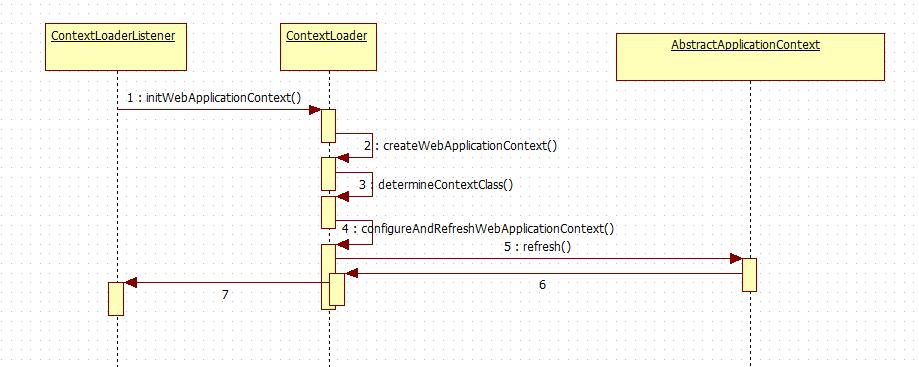Spring源码解析-Web容器启动过程
Web容器启动过程,主要讲解Servlet和Spring容器结合的内容。
流程图如下:

Web容器启动的Root Context是有ContextLoaderListener,一般使用spring,都会在web.xml中配置这个监听器。
<listener>
<listener-class>org.springframework.web.context.ContextLoaderListener</listener-class>
</listener>
下面就从这里入手,看看它是如何启动spring容器。
public class ContextLoaderListener extends ContextLoader implements ServletContextListener {
public ContextLoaderListener(WebApplicationContext context) {
super(context);
}
/**
* Initialize the root web application context.
*/
@Override
public void contextInitialized(ServletContextEvent event) {
initWebApplicationContext(event.getServletContext());
}
/**
* Close the root web application context.
*/
@Override
public void contextDestroyed(ServletContextEvent event) {
closeWebApplicationContext(event.getServletContext());
ContextCleanupListener.cleanupAttributes(event.getServletContext());
}
}
这个类继承了ContextLoader,同时实现了ServletContextListener,从注释上可以看出,web应用会调用contextInitalized方法进行初始化。
先看一下ServletContextListener.
public interface ServletContextListener extends EventListener {
void contextInitialized(ServletContextEvent var1);
void contextDestroyed(ServletContextEvent var1);
}
从名字可以看出,一个是初始化方法,另一个是销毁是调用的方法。
回到上面而initWebApplicationContext方法,通过createWebApplicationContext方法获取WebApplicationContext,调用determineContextClass方法如下:
/**
* Return the WebApplicationContext implementation class to use, either the
* default XmlWebApplicationContext or a custom context class if specified.
* @param servletContext current servlet context
* @return the WebApplicationContext implementation class to use
* @see #CONTEXT_CLASS_PARAM
* @see org.springframework.web.context.support.XmlWebApplicationContext
*/
protected Class<?> determineContextClass(ServletContext servletContext) {
String contextClassName = servletContext.getInitParameter(CONTEXT_CLASS_PARAM);
if (contextClassName != null) {
try {
return ClassUtils.forName(contextClassName, ClassUtils.getDefaultClassLoader());
}
catch (ClassNotFoundException ex) {
throw new ApplicationContextException(
"Failed to load custom context class [" + contextClassName + "]", ex);
}
}
else {
contextClassName = defaultStrategies.getProperty(WebApplicationContext.class.getName());
try {
return ClassUtils.forName(contextClassName, ContextLoader.class.getClassLoader());
}
catch (ClassNotFoundException ex) {
throw new ApplicationContextException(
"Failed to load default context class [" + contextClassName + "]", ex);
}
}
}
从注释上可以看出返回的是XmlWebApplicationContext。
回到initWebApplicationContext方法中,有一段
if (this.context instanceof ConfigurableWebApplicationContext) {
ConfigurableWebApplicationContext cwac = (ConfigurableWebApplicationContext) this.context;
if (!cwac.isActive()) {
// The context has not yet been refreshed -> provide services such as
// setting the parent context, setting the application context id, etc
if (cwac.getParent() == null) {
// The context instance was injected without an explicit parent ->
// determine parent for root web application context, if any.
ApplicationContext parent = loadParentContext(servletContext);
cwac.setParent(parent);
}
configureAndRefreshWebApplicationContext(cwac, servletContext);
}
}
会调用configureAndRefreshWebApplication方法,感觉是配置和刷新,进入方法。
protected void configureAndRefreshWebApplicationContext(ConfigurableWebApplicationContext wac, ServletContext sc) {
if (ObjectUtils.identityToString(wac).equals(wac.getId())) {
// The application context id is still set to its original default value
// -> assign a more useful id based on available information
String idParam = sc.getInitParameter(CONTEXT_ID_PARAM);
if (idParam != null) {
wac.setId(idParam);
}
else {
// Generate default id...
wac.setId(ConfigurableWebApplicationContext.APPLICATION_CONTEXT_ID_PREFIX +
ObjectUtils.getDisplayString(sc.getContextPath()));
}
}
wac.setServletContext(sc);
//获取配置的参数信息
String configLocationParam = sc.getInitParameter(CONFIG_LOCATION_PARAM);
if (configLocationParam != null) {
wac.setConfigLocation(configLocationParam);
}
// The wac environment's #initPropertySources will be called in any case when the context
// is refreshed; do it eagerly here to ensure servlet property sources are in place for
// use in any post-processing or initialization that occurs below prior to #refresh
ConfigurableEnvironment env = wac.getEnvironment();
if (env instanceof ConfigurableWebEnvironment) {
((ConfigurableWebEnvironment) env).initPropertySources(sc, null);
}
customizeContext(sc, wac);
//刷新上下文-->AbsreactApplicationContext.refresh()
wac.refresh();
}
至此,通过wac.refresh()启动Spring容器。
Spring源码解析-Web容器启动过程的更多相关文章
- spring源码:web容器启动(li)
web项目中可以集成spring的ApplicationContext进行bean的管理,这样使用起来bean更加便捷,能够利用到很多spring的特性.我们比较常用的web容器有jetty,tomc ...
- spring源码:web容器启动
web项目中可以集成spring的ApplicationContext进行bean的管理,这样使用起来bean更加便捷,能够利用到很多spring的特性.我们比较常用的web容器有jetty,tomc ...
- Fabric1.4源码解析: 链码容器启动过程
想写点东西记录一下最近看的一些Fabric源码,本文使用的是fabric1.4的版本,所以对于其他版本的fabric,内容可能会有所不同. 本文想针对Fabric中链码容器的启动过程进行源码的解析.这 ...
- Spring源码解析 – AnnotationConfigApplicationContext容器创建过程
Spring在BeanFactory基础上提供了一些列具体容器的实现,其中AnnotationConfigApplicationContext是一个用来管理注解bean的容器,从AnnotationC ...
- Spring源码解析-ioc容器的设计
Spring源码解析-ioc容器的设计 1 IoC容器系列的设计:BeanFactory和ApplicatioContext 在Spring容器中,主要分为两个主要的容器系列,一个是实现BeanFac ...
- Spring源码-IOC部分-容器初始化过程【2】
实验环境:spring-framework-5.0.2.jdk8.gradle4.3.1 Spring源码-IOC部分-容器简介[1] Spring源码-IOC部分-容器初始化过程[2] Spring ...
- 【Spring源码解析】—— 结合SpringMVC过程理解IOC容器初始化
关于IOC容器的初始化,结合之前SpringMVC的demo,对其过程进行一个相对详细的梳理,主要分为几个部分: 一.IOC的初始化过程,结合代码和debug过程重点说明 1. 为什么要debug? ...
- Spring源码解析-IOC容器的实现-ApplicationContext
上面我们已经知道了IOC的建立的基本步骤了,我们就可以用编码的方式和IOC容器进行建立过程了.其实Spring已经为我们提供了很多实现,想必上面的简单扩展,如XMLBeanFacroty等.我们一般是 ...
- Spring源码解析-IOC容器的实现
1.IOC容器是什么? IOC(Inversion of Control)控制反转:本来是由应用程序管理的对象之间的依赖关系,现在交给了容器管理,这就叫控制反转,即交给了IOC容器,Spring的IO ...
随机推荐
- 孤荷凌寒自学python第八十四天搭建jTessBoxEditor来训练tesseract模块
孤荷凌寒自学python第八十四天搭建jTessBoxEditor来训练tesseract模块 (完整学习过程屏幕记录视频地址在文末) 由于本身tesseract模块针对普通的验证码图片的识别率并不高 ...
- org.apache.spark.sql.functions汇总
测试数据: id,name,age,comment,date 1,lyy,28,"aaa bbb",20180102020325 scala> var data = spar ...
- 单元测试模块unittest使用学习
工作原理: unittest中最核心的四个概念是:test case, test suite, test runner, test fixture. 一个TestCase的实例就是一个测试用例.什么是 ...
- ubuntu16.04图形界面安装中文输入法,中文展示
打开system Settings 设置 打开设置语言 安装Language Support 点击installed languages 选择chinese 打勾,安装 安装IBus框 ...
- 持续集成之TeamCity 配置
xcopy /S /Y CodeFirstDemo\CodefirstDemo.Web D:\publish\welcome\Web
- ArrayList中modCount的作用
在ArrayList中有个成员变量modCount,继承于AbstractList. 这个成员变量记录着集合的修改次数,也就每次add或者remove它的值都会加1.这到底有什么用呢? 先看下面一段测 ...
- Android 网络编程 API笔记 - java.net 包 权限 地址 套接字 相关类 简介
Android 网络编程相关的包 : 9 包, 20 接口, 103 类, 6 枚举, 14异常; -- Java包 : java.net 包 (6接口, 34类, 2枚举, 12异常); -- An ...
- scrapy(2)——scrapy爬取新浪微博(单机版)
Sina爬虫教程 Scrapy环境搭建 环境:window10 + python2.7(包含scrapy)+ mongoDB 1.1 安装集成了python2.7的anaconda ana ...
- iOS中UIButton控件的用法及部分参数解释
在UI控件中UIButton是极其常用的一类控件,它的类对象创建与大多数UI控件使用实例方法init创建不同,通常使用类方法创建: + (id)buttonWithType:(UIButtonType ...
- css深入理解之 border
一 border-width不支持百分比值 1 不符合客观逻辑 2 w3成都一种约定吧 3 边框本身就像是一个包裹内容的界限 类似的还有outline,box-shadow text-shadow均不 ...
